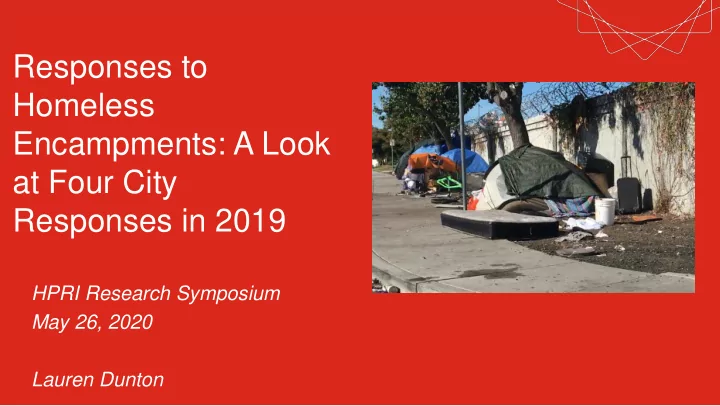

Responses to Homeless Encampments: A Look at Four City Responses in 2019 HPRI Research Symposium May 26, 2020 Lauren Dunton
Study background • Funded by HHS/ASPE and HUD/PD&R to learn more about encampments and cities’ approaches to responding to them • Findings intended to help federal, state, and local policymakers • Research included: – Literature review – Phone interviews with 9 cities – Site visits to 4 cities 2
What are encampments?
Definition of encampment • No standard definition • Common elements in formal and informal definitions include: – Continuity of location – Number of people residing at location – Presence of physical structures and personal belongings – Sense of social support or community 4
Encampment locations varied Hamilton/Pierce encampment, Houston Encampment along Guadalupe Creek, San Jose 5
Encampment size and structures • Encampments vary in size both within and between cities • Structures vary from blankets and tarps to tents to cardboard lean-tos • Sometimes common belongings and supplies shared among residents 6
Characteristics of encampment residents • Most encampment residents adults, more men than women • Encampment residents have high rate of disabling conditions, including substance use disorder and mental illness • Encampment residents often lived in the city prior to becoming homeless 7
Reasons people form encampments • Severe shortages of affordable housing • Shortcomings of shelter systems – Insufficient shelter beds – Barriers to entry (couples, pets, sobriety), program rules (hours incompatible with working); lack of personal safety and security of possessions • Sense of autonomy and community offered in encampment settings – The “encampment family” 8
City responses to encampments 9
City responses to encampments • For the largest encampments, four cities converging on a similar approach– clearance and closure with support • Support means major focus on outreach and engagement • Try to connect encampment residents with shelter or housing • May include creation of low-barrier shelters 10
Prioritization of encampment response • Cities prioritize responses to encampments that: – Are located in highly visible locations or large in size – Pose significant health, safety, and environmental hazards – Generate significant public and political pressure 11
Encampment responses Cleaning Clearance and closure Prevention • Regularly scheduled • Provide advance notice • Cities erect fencing or cleanings – basic via signage and other physical barriers sanitation and notification by outreach to prevent people from touchpoint for outreach team returning • Periodic “deep” • During clearance, store • Most common for cleanings – more property larger encampments thorough with more and those with negative • After closure, clean up implementation environmental impacts site to remove partners involved structures and mitigate • Police enforce no environmental impact camping ordinances 12
Outreach – ongoing and intensive • Invest significant time building rapport and trust with encampments residents • Cities contract with homeless service providers to conduct outreach activities • Specialized outreach teams: – Police Homeless Outreach Teams (HOTs) • Build rapport and refer to services • Enforce laws and ordinances around encampments, can make arrests if observe illegal activity – Medical and substance use outreach 13
Coordinating the effort • City government has the lead role, establishes the strategy, and coordinates the implementation partners • Partners include police, sanitation, other city departments, homeless services providers • CoC is a separate entity in these four cities so need to link to coordinated entry and outreach providers 14
Chicago key encampment activities • Focus on downsizing encampments • Prioritize largest encampments and those that generate most political pressure • Opened 28 bed low- Lower Wacker Drive encampment, Chicago, barrier Pilsen shelter October 2019. 15
Houston key encampment activities • Closed Wheeler St. encampment in 2018 • In 2019, launched initiative to permanently house residents of city’s largest encampment, Chartes • Plan to open temporary emergency shelter in Pierce/Hamilton encampment, Houston 2020 October 2019 16
San Jose key encampment activities • Many encampments along local waterways • Effort to clear and close waterway encampments led by Santa Clara Water District • Briefly created Hope Village sanctioned encampment Encampment along Guadalupe River, San Jose– October 2019 17
Tacoma key encampment activities • Closed the Jungle encampment in 2017 and created temporary Mitigation site • Established temporary emergency shelter in 2017 • In 2020, creating Temporary Emergency Micro-Shelters to clear People’s Park encampment and opening Rescue Mission emergency shelter Tacoma’s Stability Site – October 2019 18
Direct costs of encampment responses
Cost by activity type Costs by type of activity by percentage of total encampment spending, FY 2019 Outreach - total Encampment cleaning and clearance Encampment prevention Shelter PSH Other 2% 27% 4% 8% 60% TACOMA 10% 57% 15% 17% SAN JOSE 46% 26% 23% 5% HOUSTON 86% 4% 1% CHICAGO 8% 20
Spending on encampment responses Spending on encampment responses by type of organization by city, FY 2019 Police Other city departments Homeless services providers Local independent authorities Environmental non-profits 23% 16% 50% 10% HOUSTON 26% 9% 65% CHICAGO 57% 4% 6% 21% 13% SAN JOSE 23% 20% 54% 3% TACOMA 21
Encampment response funding sources Costs of encampment responses by source of funding by city, FY 2019 City Federal In-kind Private Santa Clara Water District Other sources 39% 33% 12% 5% 11% HOUSTON 91% 1% 7% CHICAGO 35% 5% 59% 1% SAN JOSE 97% 3% TACOMA 22
Study reports • Understanding Encampments of People Experiencing Homelessness and Community Responses: Emerging Evidence as of Late 2018 • City Approaches to Encampments and What They Cost • Strategies and Costs of Responding to Encampments in 2019 • Chicago, Houston, San Jose, and Tacoma Community Encampment Reports 23
Questions? Lauren Dunton – Project Director Lauren_Dunton@abtassoc.com Jill Khadduri – Principal Investigator Jill_Khadduri@abtassoc.com Nichole Fiore – San Jose Site Lead Nichole_Fiore@abtassoc.com
Recommend
More recommend